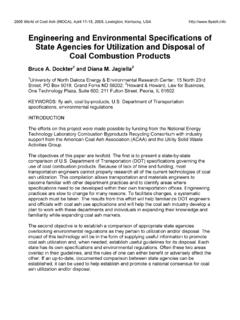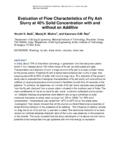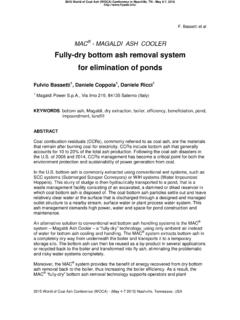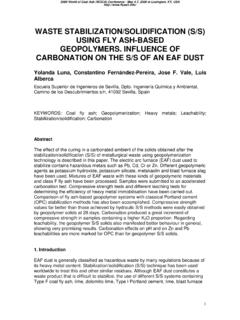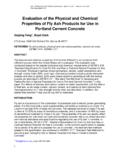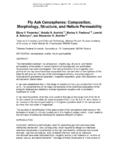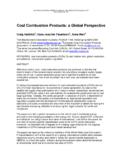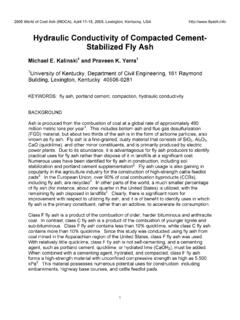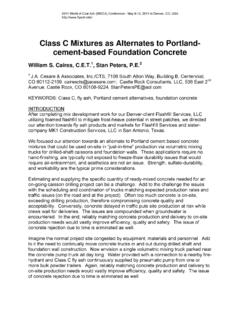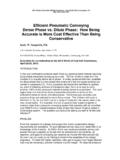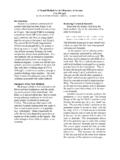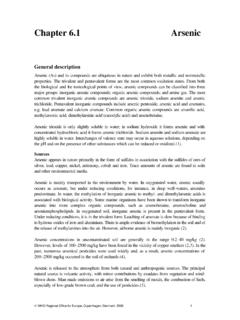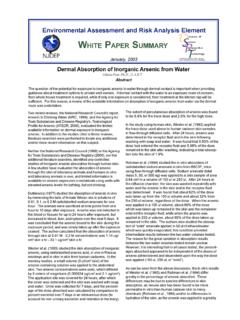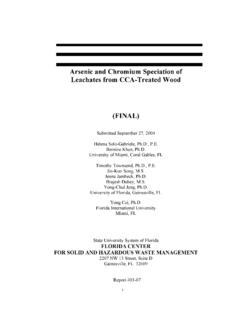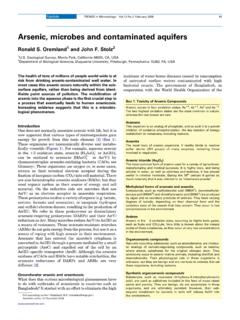Transcription of Evaluation of Inductively Coupled Plasma (ICP) …
1 Evaluation of Inductively Coupled Plasma (ICP) False Positives for arsenic and Trace Metals Analysis in Coal Ash and Coal Ash Media Richard J. Rago1 and Glen Breland2 1 Haley & Aldrich, Inc., 105 Corporate Place, Rocky Hill, CT 06067; 2 Alpha Analytical Laboratories, 8 Walkup Drive, Westborough, MA 01581 KEYWORDS: arsenic , coal ash, fly ash, SPLP, ICP, ICP/MS, leaching, TCLP, hydride, dynamic reaction cell; DRC ABSTRACT The phenomenon of potential bias in EPA Method 6010 analysis of environmental samples via Inductively Coupled Plasma (ICP) Atomic Emission Spectroscopy has long been documented. The potential for biased results, in the case of arsenic , is due to the fact that a relatively weak primary emission wavelength for arsenic is overlapped by one of several strong emission lines for aluminum.
2 Even though a 2001 Environmental Protection Agency Office of Technical Standards Alert estimated that environmental data reported using ICP may have a false-positive rate for arsenic of 25 to 50 percent, this phenomenon still receives sparse attention. One possible reason is that EPA methods provide language that interelement correction factors and background correction mechanisms should adequately compensate for these 'spectral interferences. As a result, the regulated community has often forgotten or overlooked this issue, and many may be unaware of it at all. Decision making based on data with a false positive bias could result in costly, unnecessary response actions. This paper presents the results of coal ash, coal ash media, and other environmental sample analysis by EPA Method 6010 and EPA Method 6020 (ICP/MS), as well testing via hydride generation and an Method 6020 modification utilizing a dynamic reaction cell (DRC).
3 An Evaluation of potential method bias and consideration of spectral interferences is also included. INTRODUCTION arsenic occurs naturally in trace amounts in rocks, sediments, and coal. Waters in contact with these materials have resulted in the identification of naturally occurring sources of arsenic in groundwater resources in the United States (US). A limited United States Geological Survey (USGS) study of 18,850 wells reported that the highest arsenic concentrations of arsenic in groundwater were generally identified in the West, with parts of the Midwest and Northeast also exceeding 10 ug/L1. 2011 World of Coal Ash (WOCA) Conference May 9-12, 2011 in Denver, CO, USA , a common mineral composed of iron and sulfur, can exhibit some structural replacement of sulfur with small amounts of arsenic , and is a widespread natural source of arsenic .
4 arsenic is often the most abundant micro element in pyrite and may comprise as high as 10 wt. % on a micro scale2,3. Pyrite is the primary source of arsenic in bituminous coal, with lesser contributions from the organic portions4. arsenic s strong affinity to concentrate in sulfide minerals is well documented in some coals, but it has been reported that its mode of occurrence in fly ash is less predictable5. The mode of occurrence of arsenic in fly ash is largely dependent upon the original coal source and the associated coal combustion conditions. At the temperature of coal combustion, arsenic is initially transferred to the gas phase and then deposited on fly ash particles by a mechanism of surface condensation/adsorption6. Compared to other elements in ash, arsenic enrichment is strong (5 to 10 times) in the finest (< 10 um) size fractions6,7.
5 A comparison of average arsenic content in US coals by basin indicates mean concentrations ranging parts per million (ppm) to 71 ppm4. Literature values reported for arsenic in fly ash range from 2 ppm to 440 ppm8. Evaluating the relationship between feed coal and its fly ash is complicated by the fact the coal blends are commonly used to fire boilers in the US9. Coal fly ash samples evaluated in this study include both US and South American samples that were generated from blended feed coal. POTENTIAL ANALYTICAL INTERFERENCES All methods developed for analytical determinations of trace contaminants in environmental samples are subject to physical, chemical, and/or spectral interferences. For example, extensive spectral wavelength tables have been published from data collected from dc arc, high voltage spark, and discharge tube excitation sources, such as the National Bureau of Standard's tables10 (39,000 lines) and the Massachusetts Institute of Technology (MIT) Wavelength Tables11 (approximately 110,000 lines).
6 These tables are invaluable for interpretation of spectra in spectroscopic techniques, although only the more prominent lines are generally used in day to day ICP quantification considerations12. Nevertheless, it is noteworthy that the author of the comprehensive MIT tables recognized in 1939 as having included "only half of the known spectrum lines in the region covered" and later that "..successor tables should contain information on at least ten times as many lines as are listed herein, grouped both as to parent atom and its stage of ionization, and in order of wavelengths." In summary, elements analyzed by ICP may be impacted by other elements which have direct spectral overlap, wing overlap, and nearby emission scatter. For conventional trace metal analysis, basic spectral interferences are documented and can impact a potential false positive or false negative bias on the reported results.
7 An EPA Office of Technical Standards Alert reported in 2001 that the use of the ICP analytical method for drinking water samples may result in false positive detections of arsenic , lead, and or thallium above their respective maximum contaminant levels (MCLs)13. EPA also estimated that ICP analytical data for arsenic may have a false positive rate of 25 to 50%14. False positive biases were also documented in literature in recent (2010) case studies where method quality control was otherwise acceptable15. EPA Method 6010C recommends the nm emission wavelength for arsenic and provides for interelement correction considerations for aluminum, chromium, and vanadium. For this study, method optimization resulted in laboratory selection of an alternate ICP arsenic emission wavelength for arsenic quantitation: = nm ( ) ICP-MS is also susceptible to spectral interferences which are termed isobars.
8 Isobars have the same mass/charge ratio as the analyte of interest (AOI) but are not the AOI and cannot otherwise be distinguished. For example15, ICP-MS suffers from 40Ar35Cl mass interference on the monoisotopic 75As. For the past several decades, the ICP method has been the most commonly used analytical method for routine determinations of trace metals in environmental media. The addition of ICP-MS instrumentation has recently become more prevalent in larger commercial environmental labs. While the use of hydride instrumentation and ICP-MS DRC enhancements are less prone to interferences, these methods are less commonly used in routine environmental analysis. ICP and ICP-MS interferences are of special concern since falsely biased results can lead to incorrect environmental decision making.
9 This study focuses in particular on ICP and ICP-MS data. SAMPLE PREPARATION AND ANALYTICAL METHODS Solid samples were homogenized prior to sample digestion, with fly ash sample homogenization enhanced via use of a ball mill. Solid samples were then prepared via acidic digestion using EPA Method 305016. Four analytical methods were used to test samples in this study, for which potential interferences are well documented in the methods. EPA Method 601017 was followed for Inductively Coupled Plasma atomic emission spectroscopy (ICP-AES) analysis. EPA Method 602018 was followed for Inductively Coupled Plasma mass spectrometry (ICP-MS) analysis. Instrumentation for hydride generation atomic fluorescence (HGAF)19 was used for sample analysis via a method modification of hydride generation atomic absorption EPA Methods and 163221.
10 ICP-MS instrumentation enhanced with a Dynamic Reaction Cell (DRC)22 was also utilized. In addition, samples were extracted using the Synthetic Precipitation Leaching Procedure (SPLP), EPA Method 131223, prior to analysis of arsenic in the SPLP extracts. SAMPLE SELECTION Seven representative samples of coal ash were obtained from utility companies operating coal burning units in the continental US. Three samples of uncontaminated, natural clay/silty clay deposits and one sample of uncontaminated gravel deposits were also analyzed in this study. The clay and gravel samples were collected in various locations in Central Connecticut and were included because they were expected to be naturally low in arsenic and naturally high in aluminum. All samples were given blind letter designations ( , A, B, C.)
